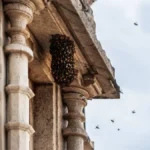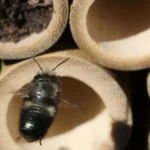When it comes to bee removals, how to keep bees from nesting in the same spot from which they were removed is an endless problem. Bee repellent and bee prevention in the form of mechanical barriers can help prevent bees from nesting in the same spot again. In this article, we take a look at how to keep bees from nesting, how to employ bee prevention and bee repellant in avoiding nests reappearing after removals.
Why Do Bee Nests Always Come Back?
In my life, I have performed hundreds of bee removals. Sometimes, I have had a phone call three days after removing a hive where the homeowner says “Your bees are back”. I show them the picture of the box I removed the bees into, and that it is full of bees. Then there is normally an argument and I have to go and remove the second swarm. Over the years, I have learned a few tricks to assist in bee prevention. We will go into these in this article.
Prime Bee Real Estate
There are certain places that bees are naturally drawn to. If you remove bees from these places, new swarms which enter the area will be attracted to the same spots. This is very much the same as for humans. Humans build cities in places. The cities get destroyed and get rebuilt. Generally, the reason is that that specific place is good for habitation.
If you have a piece of prime bee real estate, bees will keep returning to that place. After removing a bee nest, it is important to make the space “unattractive” or “invisible” to the bees. This is the domain of bee prevention.
How To Prevent Bees From Nesting in Your Home
Keeping Bees Out
Bees need to send scouts into the space to survey it for suitability for habitation. The scouts will then return and tell the rest of the hive about that space. A decision will be taken, and if the bees move into the hole, then the decision was positive. In this regard, it is clear that to keep bees out, we have to keep scout bees out.
In the case of ventilation spaces, and air bricks, and similar structures that are designed to enable airflow, ensure that these are screened completely with a stainless steel mesh. The mesh must be fine enough to keep bees out. In many cases, air vents and similar devices have a mesh in them – this is normally not a stainless mesh, and over time it rusts away. Then bees move in.

Sealing Holes
If you are very very diligent you may get this right. Sometimes bees move into structural areas where there are many holes that they can use to gain entry. If you close every hole, the bees may not return. The chances of getting this right in many cases are however quite small. Bees are excellent at finding little cracks and holes in walls and eaves.
Bee Repellant
There are many ways you can repel bees from returning to places they have nested before. As time goes on, we find that most of these repellants are actually quite toxic. It used to be normal practice to paint problem bee nesting sites with creosote tar, or carbolineum tar, or even old diesel engine oil. It is now known that, although this will keep bees away, these chemicals pose a threat to the environment in general.
In certain places where bees move into a ceiling or similar space, you may be lucky with the following method. If you can access the ceiling area place a cup of mothballs in the problem area just before spring.

If you cannot access the area, drill a hole in the ceiling that can be sealed with a cork. In spring and mid-summer, as above, place mothballs through this hole.
Bees do not like the smell of mothballs, and this means that scouts will stick their head into the cavity and leave.
My general experience is that people will do this once, and keep bees out for a year, and then forget to put more mothballs, and the bees will recur every second or so year. It is important to help the homeowner to actually place the reminder in their phone calendar and set the reminder to yearly repeat.
Long-Lasting Contact Poisons
It is best to speak to a local pest control company and ask about which long-lasting contact poisons are legal in your area. These are normally used to control ants and cockroaches. If you mention that you have an area in which ants, bees, and cockroaches periodically nest this will help.
Generally, this works on the fact that a scout will enter the cavity and die. Hence it will not call its swarm to the nesting site. This is a more destructive method and should be avoided if possible. However, there are a small number of cases where this is the best method.
As an example, I knew a person who had a horse stud in the middle of a forest. When the trees flowered, bees would move into the stables. Every now and then this would actually result in the death of a horse. In such cases, it is important to apply the appropriate controls.
Filling Cavities
This is my favorite method. Bees nest in cavities. It is easy to prevent bees from nesting in a cavity by filling the cavity. One of the easiest ways to do this is with polyurethane spray foam. The spray foam will expand and fill the cavity, leaving no place for the bees to nest.

Bee Nesting Prevention – Catch Boxes
An alternative method of bee prevention is to place catch boxes near problem spots. These baited hives will tend to be even more attractive than the problem cavity. In this way, as soon as bees move into a catch box, we remove the swarm and replace an empty box.

If you are not a beekeeper, ask a beekeeper to place catch, or bait boxes near your area to capture swarms which are in the area.
In summary, with recurring bee nests, prevention is the cure!! We hope this has helped you understand how to reduce the number of problem nests that may occur on your property. Please share widely, and remember – the best prevention is a catch box – bees are scarce, so saving bees and your house is important.
Read more about: Bees Nesting In House Walls
Bees Nesting FAQs
Why do bees keep nesting in the same spot?
Also read: How To Extract Honey From Comb At Home [Best Methods]
Bees are drawn to specific locations that offer ideal shelter, protection, and warmth. Once a spot is identified as suitable by scout bees, future swarms can return to the same location.
Also read: How to Use a Beekeeping Smoker: 5 Essential Tips
What are the best methods to prevent bees from nesting?
The best methods include sealing holes and cracks, installing fine stainless steel mesh over ventilation areas, using repellents like mothballs, and setting up bait boxes to capture swarms before they nest.
How can I seal holes to keep bees out?
Use a combination of expanding polyurethane foam, caulk, or mesh to seal entry points like cracks in walls, eaves, or roof spaces. Ensure that all possible entry points are covered to prevent scouts from entering.
What bee repellents can I use to prevent bees from returning?
Mothballs are a common non-toxic repellent for bees. Some people also use essential oils like peppermint, although the effectiveness varies. Toxic repellents like creosote should be avoided due to environmental harm.
How effective is using mothballs to repel bees?
Mothballs can be effective in repelling bees from nesting in certain cavities. Place them in the problem area before spring, but remember to replace them yearly for long-term prevention.
Can filling cavities with foam prevent bee nests?
Yes, filling cavities with expanding foam can block bees from nesting in places like walls or attics. The foam fills the entire space, eliminating potential nesting sites.
What are catch boxes, and how do they prevent bee nests?
Catch boxes, or bait boxes, are used by beekeepers to attract swarms. These boxes are placed near problem spots, and once a swarm moves into the catch box, it can be safely relocated.
Can bees be prevented without harming them?
Yes, non-lethal methods like installing mesh, using catch boxes, and placing natural repellents can prevent bees from nesting without harming them. These methods are eco-friendly and effective.
Is it necessary to hire a beekeeper for bee prevention?
If you’re not experienced with bees, it’s recommended to consult a beekeeper for setting up bait boxes or safely removing existing nests. Beekeepers can also advise on preventative measures.
How can I prevent bees from returning after removal?
To prevent bees from returning, seal off the original nest site, use repellents, and regularly check for new entry points. Installing a catch box nearby can also help divert new swarms away from your property.

Dr. Garth A. Cambray is a Canadian/South African entrepreneur and beekeeper with 28 years of experience in apiculture and specializes in adding value to honey. His Ph.D. research developed a new advanced continuous fermentation method for making mead that has resulted in a number of companies globally being able to access markets for mead. His company, Makana Meadery, exports honey mead to the USA where it is available to discerning connoisseurs. He has also developed technologies to commercially manufacture organic honey vinegar in Zambia for export globally. He holds a few patents globally in the ethanol industry and believes in technology and knowledge transfer for human development and environmental sustainability. One of his proudest achievements is the fact that the wind farm he started at one of his old apiary sites has essentially made his hometown carbon neutral.






